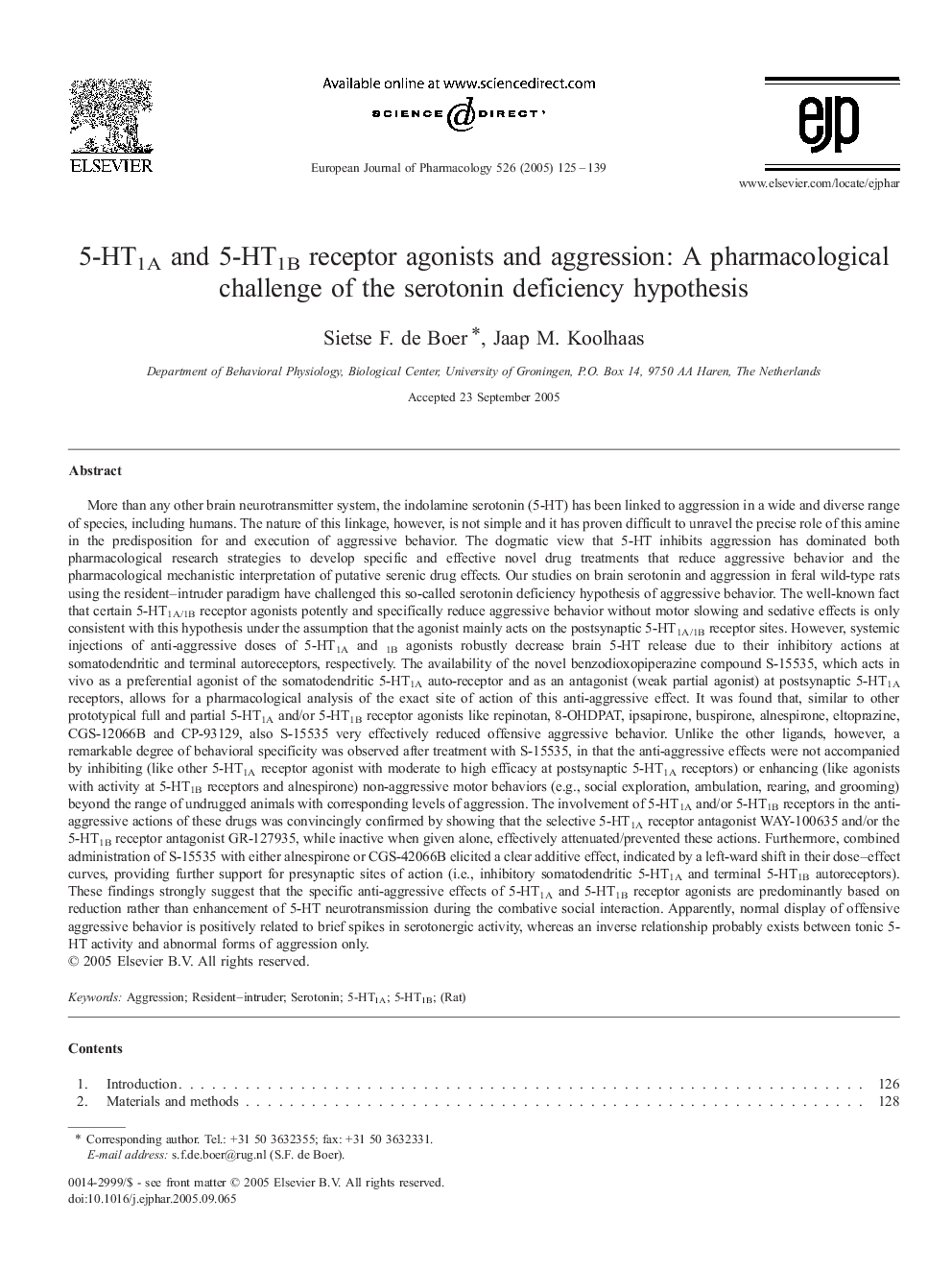| کد مقاله | کد نشریه | سال انتشار | مقاله انگلیسی | نسخه تمام متن |
|---|---|---|---|---|
| 9920962 | 1559196 | 2005 | 15 صفحه PDF | دانلود رایگان |
عنوان انگلیسی مقاله ISI
5-HT1A and 5-HT1B receptor agonists and aggression: A pharmacological challenge of the serotonin deficiency hypothesis
دانلود مقاله + سفارش ترجمه
دانلود مقاله ISI انگلیسی
رایگان برای ایرانیان
کلمات کلیدی
موضوعات مرتبط
علوم زیستی و بیوفناوری
علم عصب شناسی
علوم اعصاب سلولی و مولکولی
پیش نمایش صفحه اول مقاله

چکیده انگلیسی
More than any other brain neurotransmitter system, the indolamine serotonin (5-HT) has been linked to aggression in a wide and diverse range of species, including humans. The nature of this linkage, however, is not simple and it has proven difficult to unravel the precise role of this amine in the predisposition for and execution of aggressive behavior. The dogmatic view that 5-HT inhibits aggression has dominated both pharmacological research strategies to develop specific and effective novel drug treatments that reduce aggressive behavior and the pharmacological mechanistic interpretation of putative serenic drug effects. Our studies on brain serotonin and aggression in feral wild-type rats using the resident-intruder paradigm have challenged this so-called serotonin deficiency hypothesis of aggressive behavior. The well-known fact that certain 5-HT1A/1B receptor agonists potently and specifically reduce aggressive behavior without motor slowing and sedative effects is only consistent with this hypothesis under the assumption that the agonist mainly acts on the postsynaptic 5-HT1A/1B receptor sites. However, systemic injections of anti-aggressive doses of 5-HT1A and 1B agonists robustly decrease brain 5-HT release due to their inhibitory actions at somatodendritic and terminal autoreceptors, respectively. The availability of the novel benzodioxopiperazine compound S-15535, which acts in vivo as a preferential agonist of the somatodendritic 5-HT1A auto-receptor and as an antagonist (weak partial agonist) at postsynaptic 5-HT1A receptors, allows for a pharmacological analysis of the exact site of action of this anti-aggressive effect. It was found that, similar to other prototypical full and partial 5-HT1A and/or 5-HT1B receptor agonists like repinotan, 8-OHDPAT, ipsapirone, buspirone, alnespirone, eltoprazine, CGS-12066B and CP-93129, also S-15535 very effectively reduced offensive aggressive behavior. Unlike the other ligands, however, a remarkable degree of behavioral specificity was observed after treatment with S-15535, in that the anti-aggressive effects were not accompanied by inhibiting (like other 5-HT1A receptor agonist with moderate to high efficacy at postsynaptic 5-HT1A receptors) or enhancing (like agonists with activity at 5-HT1B receptors and alnespirone) non-aggressive motor behaviors (e.g., social exploration, ambulation, rearing, and grooming) beyond the range of undrugged animals with corresponding levels of aggression. The involvement of 5-HT1A and/or 5-HT1B receptors in the anti-aggressive actions of these drugs was convincingly confirmed by showing that the selective 5-HT1A receptor antagonist WAY-100635 and/or the 5-HT1B receptor antagonist GR-127935, while inactive when given alone, effectively attenuated/prevented these actions. Furthermore, combined administration of S-15535 with either alnespirone or CGS-42066B elicited a clear additive effect, indicated by a left-ward shift in their dose-effect curves, providing further support for presynaptic sites of action (i.e., inhibitory somatodendritic 5-HT1A and terminal 5-HT1B autoreceptors). These findings strongly suggest that the specific anti-aggressive effects of 5-HT1A and 5-HT1B receptor agonists are predominantly based on reduction rather than enhancement of 5-HT neurotransmission during the combative social interaction. Apparently, normal display of offensive aggressive behavior is positively related to brief spikes in serotonergic activity, whereas an inverse relationship probably exists between tonic 5-HT activity and abnormal forms of aggression only.
ناشر
Database: Elsevier - ScienceDirect (ساینس دایرکت)
Journal: European Journal of Pharmacology - Volume 526, Issues 1â3, 5 December 2005, Pages 125-139
Journal: European Journal of Pharmacology - Volume 526, Issues 1â3, 5 December 2005, Pages 125-139
نویسندگان
Sietse F. de Boer, Jaap M. Koolhaas,